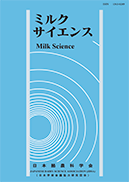All issues

Volume 46 (1997)
- Issue 3 Pages 169-
- Issue 2 Pages 81-
- Issue 1 Pages 1-
Predecessor
Volume 46, Issue 3
Displaying 1-4 of 4 articles from this issue
- |<
- <
- 1
- >
- >|
Original Reports
-
—Distribution of Free Amino Acids and Chemical Constituents in Cheese Ripened with Geotrichum candidum—Tsunehiko Kawai, Yuji Nakazawa1997 Volume 46 Issue 3 Pages 169-175
Published: 1997
Released on J-STAGE: October 31, 2015
JOURNAL FREE ACCESSWe isolated three strains of yeast, analogous Geotrichum candidum, from Camembert cheese at a farmhouse in Camembert, Normandy, France and from a farm factory in Kibi-Kogen, Okayama, Japan. These strains were named Cd, Ci and YS.
Using strain Cd as the starter, we made Camembert cheese from pasteurized milk. By shaking well, the culture of strain Cd became the best suitable phase for the starter. It consists of mycelia, which is difficult to grow, and includes much mass arthroconidia.
(1) amount of free amino acids by an amino acid autoanalyzer, (2) amount of free fatty acids, (3) aroma constituents by a gas chromatograph, and (4) amount of volatile organic acids by a high performance liquid chromatograph.
Measurements were made from the beginning of manufacture (day 0) to the final ripening period (day 35).
Concerning the distribution of free amino acids between the two kinds of cheese, the cheese without strain Cd produced less free amino acids than that with strain Cd, viz.; 15.6 μmol: 13.6 μmol in 7 days, 35.9 μmol: 29.4 μmol in 21 days, and 56.4 μmol: 51.9 μmol in 35 days.
The cheese with strain Cd contained greater amounts of each produced amino acid (i.e., serine, glutamic acid, valin, leuicine and phenylalanine) than did the cheese without strain Cd.
The amount of free fatty acids, volatile organic acids and aroma constituents were higher in the cheese with strain Cd than in the cheese without strain Cd.
This strain can improve enhanse the flavor of Camembert cheese.View full abstractDownload PDF (1282K) -
Dhanapati Neupaney, Makoto Ishioroshi, Kunihiko Samejima1997 Volume 46 Issue 3 Pages 177-182
Published: 1997
Released on J-STAGE: October 31, 2015
JOURNAL FREE ACCESSThe effect of agitation, pH and heat on the structural of bovine β-lactoglobulin A was investigated by circular dichroism and spectrophotometry. The α-helices, β-turns, β-sheets and random coils of β-lactoglobulin A were severely altered by the application of heat at various pH levels. Considerably vigorous agitation of β-lactoglobulin A significantly changed the secondary structure. The SH content of β-lactoglobulin A was higher in acid pH and it sharply decreased at alkaline pH. Secondary structure of β-lactoglobulin A was collapsed on heating of the solutions that had pH 12 or higher.View full abstractDownload PDF (1521K) -
Shaohui Zhang, Daodang Pan, Tomio Ohashi1997 Volume 46 Issue 3 Pages 183-188
Published: 1997
Released on J-STAGE: October 31, 2015
JOURNAL FREE ACCESSWhey syrup, prepared by immobilized β-galactosidase, and whey were added separately to 10% skim milk culture media, and then incubated with 2% of a fresh culture starter of Lactobacillus delbrueckii subsp. bulgaricus at 37℃ for 24 hr. The growth of Lb. bulgaricus and change in acidity were observed during the incubation. The addition of whey syrup and whey both stimulated the growth of Lb. bulgaricus in the skim milk culture media. However, the addition of whey syrup was more effective than that of whey. The lag phase of growth of Lb. bulgaricus with the addition of whey syrup was 2 hr shorter than that with the addition of whey. When whey syrup and whey were added to skim milk culture media, the acidities were higher than the control sample during incubation, suggesting that both whey syrup and whey had a good stimulatory effect on lactic acid fermentation. Furthermore, the lactic acid production was higher with the addition of whey syrup than with the addition of whey within the logarithmic phase of growth of Lb. bulgaricus. The results show that the whey syrup is a better substrate than whey for stimulating lactic acid fermentation.View full abstractDownload PDF (1512K) -
Daodong PAN, Hua LI, Shaohui ZHANG, Tomio OHASHI1997 Volume 46 Issue 3 Pages 189-192
Published: 1997
Released on J-STAGE: October 31, 2015
JOURNAL FREE ACCESSThe present study examined the effect of Flammulina velutipes polysaccharide (FVP), a kind of water soluble polysaccharide extracted from the fruiting body of Flammulina velutipes, on the growth of lactic acid bacteria of Lactobacillus delbrueckii subsp. bulgaricus 2b and lactic acid fermentation in skim milk culture media incubated at 37℃. It was found that the FVP could stimulate the bacteria growth by a reduction in the lag-phase time and promote the lactic acid fermentation. It was also found that this effect was positively related to the FVP concentration in the skim milk culture medium.View full abstractDownload PDF (994K)
- |<
- <
- 1
- >
- >|